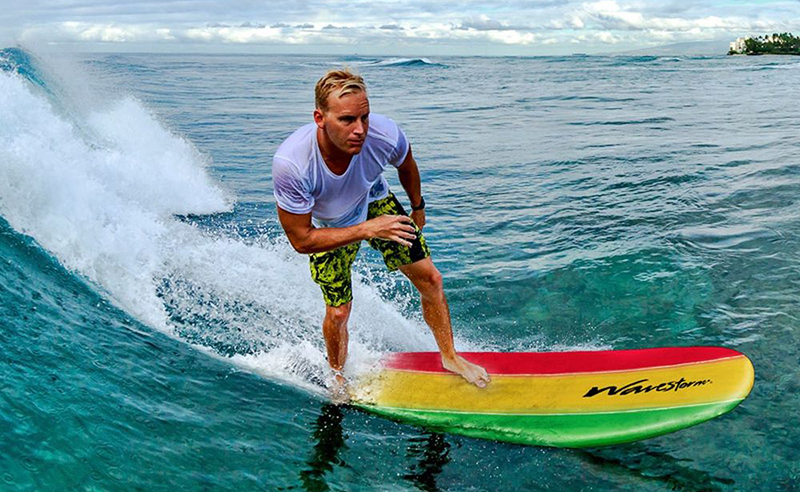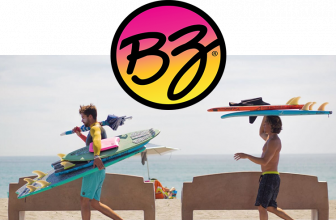
The introduction of foam blanks into the surfing industry is probably to this day one of the biggest turning points in surfing history.
Prior to foam, you could only find surfboards that were made of wood. When foam boards came around, people loved them because they were lightweight and far more maneuverable than their predecessors.
More...
While there is no agreed upon inception date for soft top boards, many agree that the “inventors” were Hobie Alter and Gordon Clark, two surfboard manufacturers who were working together a lot in the late 50s.
Their trial and error processes finally led them to create a lineup of different-sized foam boards that would eventually hit a massive production scale in the early 1960s.
The Evolution
The evolution of these soft top boards didn’t catch on until further down the line when the surfing craze began to take hold in the late 1960s. Soft-top boards became a way for idealist newbies to get out in the water and make a splash without breaking the bank or breaking their boards. They were safer, had more volume, and were much easier to ride than hard top boards.
Original Soft-Top surfboards used polyurethane foam that was encased with a type of polyester resin. While the ride was pretty soft, the overall setup flexed too much and warped overtime. It wasn’t until years down the line that technology allowed manufacturers to create boards with stronger epoxy resin and polystyrene.
Pioneers
In 2006, Costco launched the Wavestorm brand and turned the soft-top world on its head. While these boards still may be crowned the kookiest boards out in the water, they gave soft-top surfing a name and truly popularized it more than anything else.
The head of Agit Global (the producer of the now popular Wavestorm) created the board by using the same approach that many bodyboard manufacturers were using with polystyrene blanks. The only difference was that they expanded the materials to make them strong enough to stand on.
Wavestorm has gotten so big that even pro riders like Jamie O’Brien have taken the boards out big wave surfing in Oahu. Big wave surfer Shawn Dollar even went as far as to setup the Wavestorm World Championship, a yearly competition/surf party in Santa Cruz, CA. While more of an ironic gag than a competition, as it’s not affiliated with AGIT Global or Costco, it gave the Wavestorm even more of a presence.
Since then, many companies like Catch Surf, BIC, and BZ, have introduced soft-top surfboards that are serious contenders to be reckoned with.
Frequently Asked Questions
Why Did Soft-Tops Become So Popular?
Soft-Tops became popular for beginners who wanted to get out and learn how to surf. Pretty much every surf camp along the coast of California utilizes soft-top surfboards rather than fiberglass boards to teach students.
They’re much safer, much easier to ride, a whole lot easier to paddle, and offer tons of stability. For companies, they are much cheaper to produce. They’re also a fairly new idea too, and still growing and evolving everyday.
Why Should I get a Soft-Top Surfboard?
There are about a hundred reasons to get a soft top surfboard. For beginners, you can save tons of money, especially if you’re not someone who likes to dedicate themselves to things too quickly. They’re also much safer considering the fact that you’ll be wiping out left and right. If you want to keep your two front teeth, a soft-top might be your best bet.
They’re great travel surfboards and don’t ding or dent as easily as soft-top boards (we’re looking at you airline employees). Dings are such a bummer and sometimes impossible to fix. If you don’t have to deal with them, it’ll make your life 10x easier. Trust us on that one. Lastly, they perform really well compared to older soft-top surfboards. Modern technology has allowed shapers to create soft-tops that are maneuverable and shred-able.
Are soft-top surfboards kooky?
The answer will depend on whom you talk to, but speaking from experience, every surfer we know has a soft-top in his or her quiver nowadays.
They can take on small surf that your glassed shortboard can’t and are perfect for getting out in the water and having some fun without worrying about what other think!
Final Thoughts
So we can’t lie and tell you that soft-tops will ever replace traditional hardtop surfboards. Fiberglass will always excel in maneuverability and speed.
Soft-tops are simply not for expert surfers.
Sure, you can have fun pounding around on a Wavestorm in the water, but if you’re looking to compete or bust a few airs, they’re likely not going to work.
That being said, the future for soft-tops is looking bright, and we’re positive that in the next decade or so, the market will double for our foamie friends.





